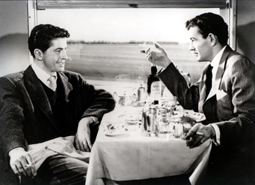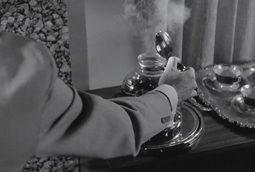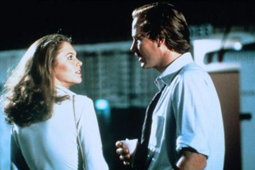Crime Films, 1940 – 2000: A Free Film Festival
Part of Lancaster University Library’s
Tom Milne Popular Fiction Archive: 2012 Exhibition, Texts into Films
The Festival runs from Friday 20th January to Friday 27th January, and is open to all members of Lancaster University. It will show a mixture of classic film noir and post-1960s neo-noir every evening in the Elizabeth Livingstone Lecture Theatre. All of the films are based on books displayed in the Exhibition.
The 2012 Tom Milne Popular Fiction Archive Exhibition takes place 17th January – 9th March in the University Library. The Milne Archive and the current Festival have been funded by a generous donation from the Lancaster University Friends Programme. For information about the Exhibition, contact Louise Tripp: 01524 592546
Download our poster and brochure.
FILM SHOWINGS 20th JANUARY to 27th JANUARY
- FRIDAY 20th JAN: Maltese Falcon 6.00 – 7.40; Farewell My Lovely 8.00 – 9.35
- MONDAY 23rd JAN: Double Indemnity 6.00 – 7.50; and Body Heat 8.30 – 10.30
- TUESDAY 24th JAN: Cape Fear 6.00 – 7.45; and Point Blank 8.15 – 10.00
- WEDNESDAY 25th JAN: Shoot the Piano Player 6.00 – 7.20; Strangers on a Train 8.00 – 9.50
- THURSDAY 26th JAN: Jackie Brown 9.00 – 12.00
- FRIDAY 27th JAN: The Big Heat 6.00 – 7.30; and The Grifters 8.00 – 9.50
FRIDAY 20th JAN: Maltese Falcon 6.00 – 7.40; Farewell My Lovely 8.00 – 9.35
The Maltese Falcon
 A respected addition to the noir canon from the get-go, John Huston’s The Maltese Falcon (1941) encapsulates so much of the genre tradition. Humphrey Bogart is Sam Spade, a morally ambiguous private eye enlisted by the beautiful Miss Wonderly (Mary Astor) to find her sister’s lover. What should be a routine job turns into a nightmare as Spade finds himself chief suspect in a double-murder and embroiled in a chaotic search for the mysterious Maltese falcon. A film bursting with twists and turns, The Maltese Falcon is unpredictable, inescapably seductive and a deliciously noir masterpiece.
A respected addition to the noir canon from the get-go, John Huston’s The Maltese Falcon (1941) encapsulates so much of the genre tradition. Humphrey Bogart is Sam Spade, a morally ambiguous private eye enlisted by the beautiful Miss Wonderly (Mary Astor) to find her sister’s lover. What should be a routine job turns into a nightmare as Spade finds himself chief suspect in a double-murder and embroiled in a chaotic search for the mysterious Maltese falcon. A film bursting with twists and turns, The Maltese Falcon is unpredictable, inescapably seductive and a deliciously noir masterpiece.
Notes on the text: Dashiell Hammett’s Maltese Falcon was serialized in five parts in Black Mask in 1929-30 before being published in book form in 1930 by Knopf. Three films were based on it, produced in 1931, 1936 (Satan Met a Lady) and, best-known, the John Huston-directed Humphrey Bogart film of 1941. Hammett’s greatest novels – Red Harvest, The Dain Curse, Maltese Falcon and The Glass Key – were all published first as Black Mask serials and established the hard-boiled style of American crime writing.
Farewell My Lovely
 Renamed Murder My Sweet in America for fear of sounding like one of Dick Powell’s musicals, Farewell My Lovely (1944) boasts one of noir’s most famous heroes created by one of the genre’s most cherished writers. Raymond Chandler’s Philip Marlowe, played with relish by Powell, is a private detective hired first by two-bit hood Moose Malloy to find a showgirl he fell in love with and then by the enigmatic Helen Grayle to retrieve her stolen jade necklace. The further Marlowe investigates, the deeper he falls into a murky underworld of deception and danger, resulting in one shadowy encounter after another.
Renamed Murder My Sweet in America for fear of sounding like one of Dick Powell’s musicals, Farewell My Lovely (1944) boasts one of noir’s most famous heroes created by one of the genre’s most cherished writers. Raymond Chandler’s Philip Marlowe, played with relish by Powell, is a private detective hired first by two-bit hood Moose Malloy to find a showgirl he fell in love with and then by the enigmatic Helen Grayle to retrieve her stolen jade necklace. The further Marlowe investigates, the deeper he falls into a murky underworld of deception and danger, resulting in one shadowy encounter after another.
Notes on the text: Raymond Chandler’s 2nd novel, Farewell My Lovely (1940,) was adapted 3 times for the cinema, in 1942, 1944 and (with Robert Mitchum) in 1975. It was the 2nd novel to feature his ‘knight of the mean streets’, Philip Marlowe. Chandler, whose career started with Black Mask in 1933, wrote seven Marlowe adventures, and films have been made of all but one of his novels.
MONDAY 23rd JAN: Double Indemnity 6.00 – 7.50; and Body Heat 8.30 – 10.30
Double Indemnity
 The quintessential film noir, Billy Wilder’s Double Indemnity (1944) features a devilish dame and a flawed man as they plot to bump off her husband to pocket the life insurance. Framed by an opening scene confession, Wilder and Raymond Chandler’s adaptation of James M. Cain’s novel is brimming with betrayal and loaded dialogue as seedy insurance-salesman Walter Neff (Fred MacMurray) falls into the enigmatic Phyllis Dietrichson’s (Barbara Stanwyck) web of seduction, money-lust and cold-blooded deception. As the lies grow larger, the lovers come under suspicion, but who poses the bigger threat – Neff’s tenacious boss or themselves?
The quintessential film noir, Billy Wilder’s Double Indemnity (1944) features a devilish dame and a flawed man as they plot to bump off her husband to pocket the life insurance. Framed by an opening scene confession, Wilder and Raymond Chandler’s adaptation of James M. Cain’s novel is brimming with betrayal and loaded dialogue as seedy insurance-salesman Walter Neff (Fred MacMurray) falls into the enigmatic Phyllis Dietrichson’s (Barbara Stanwyck) web of seduction, money-lust and cold-blooded deception. As the lies grow larger, the lovers come under suspicion, but who poses the bigger threat – Neff’s tenacious boss or themselves?
Notes on the text: James M. Cain wrote Double Indemnity as an eight-part serial, published in Liberty magazine in 1936. It was based on the trial of Ruth Snyder and Judd Gray for murdering Snyder’s husband in 1927. Several studios wanted to film Cain’s novella in the 1930s, but Joseph Breen of the Hays Office warned, “The general low tone and sordid flavor of this story makes it, in our judgment, thoroughly unacceptable for screen presentation before mixed audiences in the theater.” It wasn’t finally filmed until Paramount bought the rights in the early 1940s; it was later remade for TV in 1973 and is parodied in Carl Reiner’s Fatal Instinct (1993).
Body Heat
Lawrence Kasdan’s directorial debut Body Heat (1981) was at the forefront of the neo-noir movement, with a plot paying the ultimate homage to vintage femme-fatale noir. William Hurt is Ned Racine, a sleazy, hapless lawyer who begins a torrid affair with the married Matty Walker, played knowingly by Kathleen Turner, in the midst of a sticky Floridian heat wave. Fuelled by lust and money, the lovers decide to kill her husband but, as the heat thickens around them so does suspicion, and it’s soon only a matter of time before passion cools and paranoia flares.
Notes on the text: Body Heat is a loose remake of Wilder’s Double Indemnity and Cain’s novella.
TUESDAY 24th JAN: Cape Fear 6.00 – 7.45; and Point Blank 8.15 – 10.00
Cape Fear
 Perhaps overshadowed by Martin Scorsese’s nineties remake, J. Lee Thompson’s Cape Fear (1962) is an unflinching look at the predatory man and the dangers he poses to society. Adapted from John D. MacDonald’s The Executioners, the film tells the story of the recently released Max Cady (an unnerving Robert Mitchum), a rapist who vows revenge on Sam Bowden (Gregory Peck), the witness whose testimony put him away. After Cady threatens his wife and teenage daughter, Bowden has to decide whether to leave it to the law or take matters into his own hands and stop the terror himself.
Perhaps overshadowed by Martin Scorsese’s nineties remake, J. Lee Thompson’s Cape Fear (1962) is an unflinching look at the predatory man and the dangers he poses to society. Adapted from John D. MacDonald’s The Executioners, the film tells the story of the recently released Max Cady (an unnerving Robert Mitchum), a rapist who vows revenge on Sam Bowden (Gregory Peck), the witness whose testimony put him away. After Cady threatens his wife and teenage daughter, Bowden has to decide whether to leave it to the law or take matters into his own hands and stop the terror himself.
Notes on the text: John D. MacDonald’s The Executioners (1957) was adapted as Cape Fear both in 1962 and in 1991 (the Scorsese remake stars Robert De Niro, Nick Nolte and Jessica Lange). MacDonald was a prolific writer, producing both a famous investigative series (featuring Travis McGee) and dozens of non-series novels.
Point Blank
 Revenge with a stylistic twist is at the heart of John Boorman’s dreamlike Point Blank (1967). The film opens with a dazzling sequence of fast cuts and arresting images. Lee Marvin’s Walker is betrayed by his gangster friend Reese and adulterous wife as they steal his money and fill him with bullets, leaving him for dead in an abandoned Alcatraz. Walker survives and sets out on an unrelenting quest for his $93,000 as well as vengeance on Reese, his wife and all of their accomplices in the shadowy ‘Organization’. With its disorientating avant-garde style, Point Blank is often unsettling but undeniably riveting.
Revenge with a stylistic twist is at the heart of John Boorman’s dreamlike Point Blank (1967). The film opens with a dazzling sequence of fast cuts and arresting images. Lee Marvin’s Walker is betrayed by his gangster friend Reese and adulterous wife as they steal his money and fill him with bullets, leaving him for dead in an abandoned Alcatraz. Walker survives and sets out on an unrelenting quest for his $93,000 as well as vengeance on Reese, his wife and all of their accomplices in the shadowy ‘Organization’. With its disorientating avant-garde style, Point Blank is often unsettling but undeniably riveting.
Notes on the text: Donald Westlake’s The Hunter (1962), written under the pseudonym Richard Stark, features a career criminal called Parker (renamed Walker in Boorman’s film). The Hunter was also adapted by Ringo Lam as Full Contact (1993), starring Chow Yun-fat, and as Payback (1999), starring Mel Gibson; the 3rd Parker novel, The Outfit, was filmed in 1973, directed by John Flynn and starring Robert Duvall.
WEDNESDAY 25th JAN: Shoot the Piano Player 6.00 – 7.20; Strangers on a Train 8.00 – 9.50
Shoot the Piano Player
 Embracing his New-Wave cool, Francois Truffaut’s Shoot the Piano Player (1960) – a loose adaptation of David Goodis’ pulp crime novel Down There – is an inherently European pastiche of American noir. Broken by his tragic marriage, Charlie (Charles Aznavour) is a shy ex-concert pianist playing in low-rent bars and mooning over waitress Lena (Ingrid Bergman lookalike Marie Dubois), until his brothers inadvertently draw the two of them into a feud with a pair of bumbling gangsters. Flitting between farcical humour and dark noir violence, Shoot the Piano Player is a mischievous and affectionate subversion of American cinema.
Embracing his New-Wave cool, Francois Truffaut’s Shoot the Piano Player (1960) – a loose adaptation of David Goodis’ pulp crime novel Down There – is an inherently European pastiche of American noir. Broken by his tragic marriage, Charlie (Charles Aznavour) is a shy ex-concert pianist playing in low-rent bars and mooning over waitress Lena (Ingrid Bergman lookalike Marie Dubois), until his brothers inadvertently draw the two of them into a feud with a pair of bumbling gangsters. Flitting between farcical humour and dark noir violence, Shoot the Piano Player is a mischievous and affectionate subversion of American cinema.
Notes on the text: David Goodis’s Down There (1956) was adapted as Shoot the Piano Player (Tirez sur le pianiste) in 1960. Between the 1940s and the present, over a dozen Goodis novels have been adapted for the screen, including Dark Passage in 1947, directed by Delmer Daves, starring Humphrey Bogart and Lauren Bacall.
Strangers on a Train
 The infamous master of suspense, Alfred Hitchcock directed numerous films depicting murders most terrible, and his adaptation of Patricia Highsmith’s Strangers on a Train in 1951 is no exception. A chance meeting between Guy Haines (Farley Granger) and extravagant Bruno Anthony (Robert Walker) culminates in Anthony proposing the perfect exchange of murders: Haines’ vindictive ex-wife for his own father. Though Haines laughs off the suggestion, Anthony is deadly serious and soon pulls them both into a downward spiral of blackmail and death. Concluding with one of Hitch’s finest set-pieces, Strangers on a Train is a gripping exploration of guilt by association.
The infamous master of suspense, Alfred Hitchcock directed numerous films depicting murders most terrible, and his adaptation of Patricia Highsmith’s Strangers on a Train in 1951 is no exception. A chance meeting between Guy Haines (Farley Granger) and extravagant Bruno Anthony (Robert Walker) culminates in Anthony proposing the perfect exchange of murders: Haines’ vindictive ex-wife for his own father. Though Haines laughs off the suggestion, Anthony is deadly serious and soon pulls them both into a downward spiral of blackmail and death. Concluding with one of Hitch’s finest set-pieces, Strangers on a Train is a gripping exploration of guilt by association.
Notes on the text: Strangers on a Train (1950), filmed by Hitchcock in 1951,was Patricia Highsmith’s first novel. She continued writing psychological noir until the 1990s, including five novels about the murderer Tom Ripley. There have been over two dozen film and television adaptations of Highsmith’s work.
THURSDAY 26th JAN: Jackie Brown 9.00 – 12.00
Jackie Brown
A rendition of Elmore Leonard’s Rum Punch, and the only novel adaptation on his résumé, Quentin Tarantino’s Jackie Brown (1997) is arguably the most intelligent film in the director’s back-catalogue. Still retaining his previous pulp-noir flourishes, Tarantino throws in even more postmodern pastiche as ex-blaxploitation heroine Pam Greer plays the titular air-hostess caught between jail and Samuel L. Jackson’s malignant gun-dealer after she’s arrested for couriering money. Also revealing Tarantino’s more subtle capabilities, particularly with Robert Forster’s love-struck bail-bondsman, Jackie Brown proves that when you absolutely, positively got to have a rich and rewarding slice of crime, accept no substitutes.
Notes on the text: Rum Punch (1992), filmed as Jackie Brown by Tarantino in 1997, is only one of the many Elmore Leonard novels and stories that have been adapted for the cinema and television since the 1950s. In a career that spans 60 years, Leonard has written over 40 novels as well as numerous screenplays and short stories, establishing himself as the best-known crime fiction writer in America.
FRIDAY 27th JAN: The Big Heat 6.00 – 7.30; and The Grifters 8.00 – 9.50
The Big Heat
 Adapted by former crime reporter Sydney Boehm, and directed by Fritz Lang, The Big Heat (1953) is a brutal slice of crime noir. Opening with a suspicious suicide and a suspected cover-up, the film powers through police corruption and criminal supremacy as cop Glenn Ford tries to separate the bad guys from the good, hitting on his own personal need for vengeance and justice along the way. With truly memorable scenes – mostly involving Lee Marvin’s violent hood and Gloria Grahame’s likeable moll – and an uncompromising take on heroism, The Big Heat is film noir at its nihilistic best.
Adapted by former crime reporter Sydney Boehm, and directed by Fritz Lang, The Big Heat (1953) is a brutal slice of crime noir. Opening with a suspicious suicide and a suspected cover-up, the film powers through police corruption and criminal supremacy as cop Glenn Ford tries to separate the bad guys from the good, hitting on his own personal need for vengeance and justice along the way. With truly memorable scenes – mostly involving Lee Marvin’s violent hood and Gloria Grahame’s likeable moll – and an uncompromising take on heroism, The Big Heat is film noir at its nihilistic best.
Notes on the text: William P. McGivern wrote The Big Heat in 1952 and it was adapted by Lang in the following year. McGivern was a novelist and television scriptwriter, several of whose novels were adapted for the cinema, including Rogue Cop (1954) and Odds Against Tomorrow (1959).
The Grifters
Opening with 1970s style credits, Martin Scorsese’s voiceover and a three-way split-screen introducing each main player, Stephen Frears’ The Grifters is one of the most playfully self-conscious of neo-noir films. Adapted by crime writer Donald Westlake from Jim Thompson’s novel, the story centres on three con artists: Lilly (Anjelica Huston), a playback money handler for a ruthless bookie; Roy (John Cusack), her estranged son who deals in dice and bar-grifts; and Roy’s long-con leaning lover Myra (Annette Bening). When a con goes wrong, Roy inadvertently pulls the trio together, sparking a battle of wills and paving the way for a shocking finale.
Notes on the text: Stephen Frear’s 1990 version of Jim Thompson’s The Grifters (1963) is the best of many film adaptations of Thompson’s novels. Most noted for the dark, transgressor-centred paperback originals he published from the late 1940s through the 1960s, Thompson was proclaimed by the French to be “le plus noir”, the most American and the most pessimistic of the noir thriller writers.
Film reviews by Lauren Randall, January 2012




